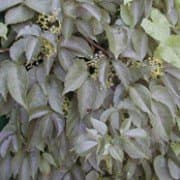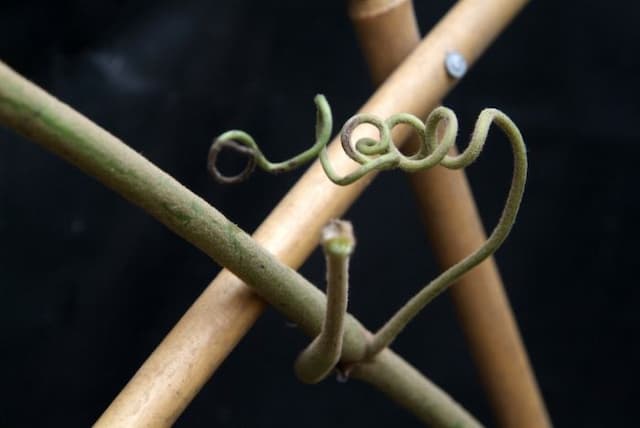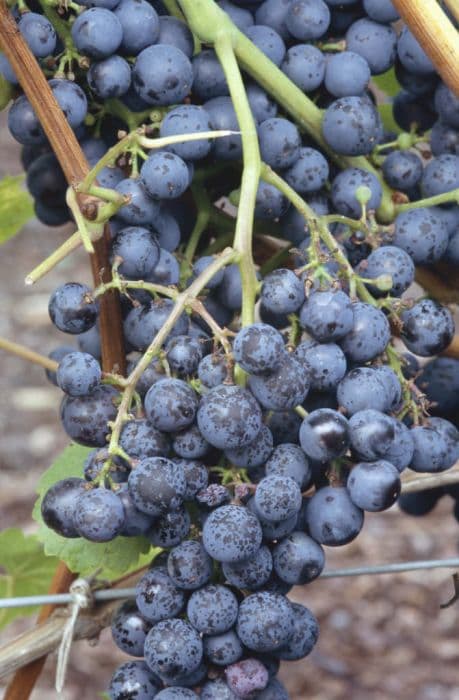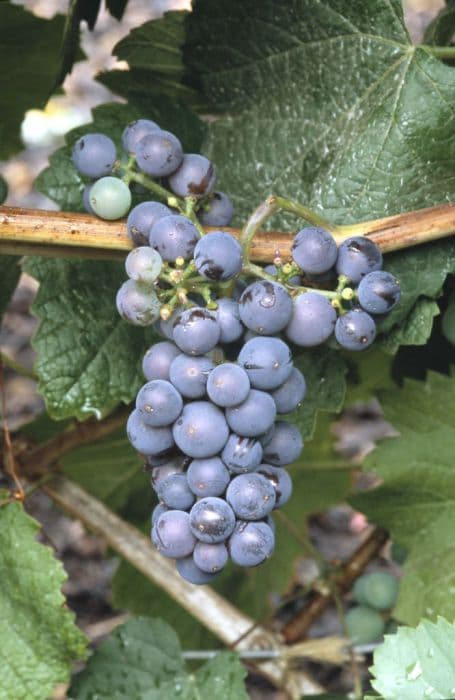Strawberry Grape Vitis 'Fragola' (O/r)

ABOUT
Vitis 'Fragola' commonly known as Strawberry Grape is a type of grapevine that is well-regarded for its unique and aromatic berries. The plant showcases a classic vine growth habit with twining tendrils that grasp onto supports, enabling it to climb with a vigorous nature. The leaves of this grapevine are broad and heart-shaped, with a lush green color that often turns to beautiful shades of yellow or red in the fall, marking the change in seasons. The edges of the leaves are serrated, with each leaf displaying a prominent central vein from which smaller veins branch out like the ribs of a fan. One of the most notable features of the Strawberry Grape is its fruit clusters. The grapes themselves are small to medium in size and typically display a deep, ruby red hue when ripe. They are known for their intense, sweet flavour that is reminiscent of strawberries, alongside the typical grape taste, hence the name. These grapes come together in conical shaped bunches, hanging down from the vine in an alluring display that invites picking. The term "O/r" associated to the plant name potentially indicates that it is disease-resistant or pertains to an original variety or rootstock, although without further context it's hard to define precisely. Overall, the appearance of the Strawberry Grape vine is both attractive and productive, providing a bounty of uniquely flavored grapes along with ornamental beauty throughout the growing season.
About this plant
 Names
NamesFamily
Vitaceae
Synonyms
Strawberry Grape, Fragola Vine, Strawberry Vine
Common names
Vitis 'Fragola'
 Toxicity
ToxicityTo humans
Strawberry grape is not considered toxic to humans. In fact, its grapes are edible and widely appreciated for their unique, strawberry-like flavor. However, ingesting large quantities of the leaves could potentially cause stomach upset because leaves contain high levels of tannins.
To pets
Strawberry grape can be toxic to pets, especially dogs and cats. The toxic principle in grapes is not fully understood, but it can cause acute renal failure. Symptoms of grape poisoning in pets can include vomiting, diarrhea, lethargy, abdominal pain, and decreased urine production. If a pet ingests grapes, it is important to seek immediate veterinary care.
 Characteristics
CharacteristicsLife cycle
Perennials
Foliage type
Deciduous
Color of leaves
Green
Height
10 feet (3.05 meters)
Spread
10 feet (3.05 meters)
Plant type
Climber
Hardiness zones
Varies
Native area
Europe
Benefits
 General Benefits
General Benefits- Edible Fruit: The Fragola grape produces sweet, edible fruit that can be enjoyed fresh, made into jam, or used in winemaking.
- Aesthetic Appeal: With its attractive foliage and clusters of grapes, it adds visual interest to any garden or landscape.
- Habitat for Wildlife: The plant offers food and shelter to various species of birds and insects.
- Shade Provider: The vine can create shaded areas, which can be beneficial for outdoor comfort and reducing energy costs in adjacent buildings.
- Erosion Control: The root system helps stabilize soil and control erosion, particularly on slopes or banks.
- Cultural Significance: Being a grapevine, it is historically significant in various cultures for its role in winemaking and cuisine.
 Medical Properties
Medical Properties- Antioxidant properties: The grape can contain compounds like resveratrol, flavonoids, and tannins, which have antioxidant effects.
- Cardiovascular health: Resveratrol in grapes is thought to contribute to heart health by improving blood flow and reducing inflammation.
- Anti-inflammatory effects: Components in grapes may help reduce inflammation in the body.
 Air-purifying Qualities
Air-purifying QualitiesThis plant is not specifically known for air purifying qualities.
 Other Uses
Other Uses- Fragola grapes can be used to create natural dyes for fabrics, with the skins imparting a range of purple and bluish tints depending on the mordant used.
- The tendrils of Fragola vines can be crafted into decorative elements for wreaths or as natural ties in garden trellising.
- Leaves from the Fragola plant can be stuffed with a mixture of rice, spices, and meat or other fillings to make traditional Mediterranean dolmas.
- Fragola grapevines, when pruned, can serve as kindling or be used to add a smoky flavor when barbecuing meats and vegetables.
- The pressed remains of Fragola grapes after juicing, known as pomace, can be composted to enrich garden soil with organic material.
- Older Fragola grapevines can be repurposed into furniture or art pieces, capitalizing on their twisted and gnarled appearance.
- Fragola grapes can be utilized in making grape vinegar, which is an aromatic addition to culinary dishes.
- The sugar-rich juice of Fragola grapes can be fermented to create a homemade grape-based yeast for baking.
- During fall, the changing leaves of the Fragola vine can be collected and used for seasonal decorations or natural craft materials.
- When dried, the seeds of Fragola grapes can be used as a natural abrasive for cleaning or polishing.
Interesting Facts
 Feng Shui
Feng ShuiThe strawberry grape is not used in Feng Shui practice.
 Zodiac Sign Compitability
Zodiac Sign CompitabilityThe strawberry grape is not used in astrology practice.
 Plant Symbolism
Plant Symbolism- Fertility: Vines, like the Fragola grapevine, are often associated with growth and fertility due to their prolific nature and ability to produce abundant fruit.
- Abundance: Grapes have been a symbol of abundance throughout history because of their clusters that yield plenty of fruits.
- Vitality: The Fragola, or Strawberry grape's vigorous growth and lush foliage often represent life and vitality.
- Transformation: The process from vine to wine is a symbol of transformation, reflecting change and development.
- Prosperity: Because grapevines are a source of valuable fruit and wine, which has historically been a luxury, they can symbolize economic prosperity.
- Festivity and Celebration: Wine made from Strawberry grapes is often associated with joy, celebrations and gatherings, making the vine represent festivity.
- Indulgence: Given their sweet taste and use in desserts and wines, Strawberry grapes can also symbolize pleasure and indulgence.
 Water
WaterThe Strawberry Vine should be watered deeply once a week during the growing season, ensuring that the soil is moist but not waterlogged. During hot, dry periods, increase watering to twice per week, providing about 1 gallon per vine. In the dormant season, reduce watering to every two weeks, unless there is significant rainfall. Always check the soil moisture at a depth of a few inches to ensure it's not too dry before watering again.
 Light
LightStrawberry Vines require full sun to produce the best fruit, meaning they should receive at least 6 to 8 hours of direct sunlight daily. The ideal spot for planting would be in an area that is not shaded by buildings or trees, and where the plant can receive unfiltered sunlight throughout the day.
 Temperature
TemperatureStrawberry Vines grow best in a temperate climate with temperatures ranging between 55°F and 85°F. They are hardy and can survive minimum temperatures down to about 20°F; however, prolonged exposure to temperatures below this can damage the plant. The vines should not be exposed to extreme heat above 95°F, as this can affect fruit quality and plant health.
 Pruning
PruningPrune Strawberry Vines in late winter or early spring before new growth begins. Remove any dead or diseased wood and thin out overcrowded areas to improve air circulation and sunlight penetration. Pruning encourages healthy growth and can increase fruit production, so it should be done annually for the best results.
 Cleaning
CleaningAs needed
 Soil
SoilStrawberry Vine or Fragola Grape requires well-draining soil with a pH between 5.5 and 7.0. A good mix would be one-third topsoil, one-third sand or perlite, and one-third compost or well-rotted manure to provide nutrients.
 Repotting
RepottingStrawberry Vine should be repotted every 2 to 3 years into a slightly larger container, ideally during the dormant season, usually in late winter or early spring.
 Humidity & Misting
Humidity & MistingFragola Grapes thrive best in moderate humidity levels, around 40-60%. They are adaptable but avoid extremely low humidity conditions.
 Suitable locations
Suitable locationsIndoor
Place Fragola Grape in bright, indirect light, with support for climbing.
Outdoor
Plant in sunny spot, train on trellis, protect from harsh winds.
Hardiness zone
7-9 USDA.
 Life cycle
Life cycleThe common name for Vitis 'Fragola' (O/r) is the Strawberry Grape. Initially, this plant begins as a dormant cutting or graft on rootstock, taking root in well-drained soil, often in temperate climates suitable for grape cultivation. It breaks dormancy in spring, producing shoots that develop leaves and tendrils, capable of climbing structures or spreading along the ground. Following vegetative growth, the plant enters the flowering stage, where small, greenish flowers pollinate and set fruit typically in late spring to early summer. The grapes develop through summer, with the strawberry-like fragrant fruits ripening to a red-purple hue by late summer or early autumn, at which point they are ready for harvest. Post-harvest, the plant gradually enters dormancy once more as temperatures drop in the fall, with the cycle repeating itself the following spring.
 Propogation
PropogationPropogation time
Spring-Early Summer
Vitis 'Fragola', commonly known as Strawberry Grape, is usually propagated by hardwood cuttings. This method involves taking a cutting from a mature plant during the dormant season, which is typically in late fall to winter. The chosen cutting should have several nodes and be about 8 to 12 inches (20 to 30 centimeters) long. The lower end of the cutting is then dipped in rooting hormone to facilitate root growth and planted in well-draining soil. It is important to keep the soil moist but not waterlogged while the cutting establishes roots. This method of propagation is popular because it is relatively simple and has a high success rate with grapevines, creating a new plant that is genetically identical to the parent.

![Grape [Claret Cloak]](/_next/image?url=https%3A%2F%2Fplants-admin.emdemapps.com%2Fimages%2Fplants%2F%2Fimages%2F604b602abe2f8.png&w=640&q=75)







